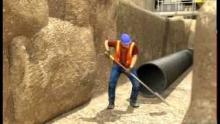12 Tips to Help Ensure the Safety of Your Employees
While underground work is one of the most dangerous sectors of the construction industry, many accidents can be easily prevented by using shoring equipment and following proper safety practices.
A wide variety of shields, sheeting, and other shoring systems are available to meet the specific needs of your underground construction site.
TO HELP ENSURE THE SAFETY OF YOUR EMPLOYEES:
- Never enter an unprotected trench. Always use a system for trenches 5 feet deep or greater. Exposed trench faces that are more than 5 feet high must be stabilized by either shoring, sloping the face of the wall back to a stable slope, or some equivalent method.
- Pre-job planning is vitally important to keeping your employees safe when trenching. The soil must be evaluated so you can select an appropriate protective system. Utilities must be contacted so they identify their underground lines. Traffic control may be an issue, and an attempt to identify previous history must be made to learn if the excavation has been previously backfilled.
- Materials used for trench boxes, sheeting, sheet piling, shoring and underpinning should be in good condition. They should be installed to provide effective support to the bottom of the trench. Vertical in the bracing system should be extended to elevation no less than 1 foot above the top of the face.
- Excavations, the adjacent areas, and protective must be inspected by a competent person for possible hazards before construction begins, daily before each shift, and following rainstorms or other hazard-increasing events.
- The person in charge must be trained in soil, the use of protective systems, knowledgeable about OSHA requirements, and have the authority to immediately eliminate hazards.
- A registered professional engineer must be used to design a protective system for trenches 20 feet deep or greater.
- Sloping can be used to protect workers by cutting back the trench wall at an angle inclined away from the excavation not steeper than a height/depth ratio 1.5:1, according to the sloping requirements for the type of soil.
- Set spoils and equipment at least 2 feet back from the excavation. When using retaining devices, such a trench box, be sure they extend above the top of the trench to prevent equipment and spoils from back into the excavation. Where the site doesn’t permit a 2-foot setback, spoils may need to be hauled to another location.
- Always provide a way to exit a trench—such as a, stairway or ramp—placed no more than 25 feet employees in the trench.
- Keep excavations open the minimum amount of time needed to complete operations.
- The trench should be braced and shored during excavation and before personnel are allowed entry. Cross braces and trench jacks should be secured in true horizontal positions and spaced vertically in order to prevent trench wall material from sliding, falling or otherwise moving into the trench.
- During the backfill operation, backfill and remove trench supports together, beginning at the bottom of the trench. Release jacks or braces slowly. In unstable soil materials, use ropes to pull them from above after employees have left the trench.

 WARNING
WARNING